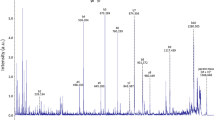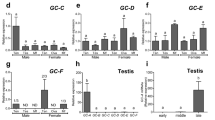Abstract
IN elasmobranch fishes, in which fertilization is internal, the caudal portion of the pelvic fin of the male is prolonged to form a stout rod-like copulatory organ or ‘clasper’. The clasper is rolled up in a scroll-like fashion, enclosing on its medial side the so-called clasper groove or tube, along which at copulation the spermatozoa pass from the urogenital papilla of the male to the oviducts of the female. The clasper groove communicates with an accessory organ, located under the skin of the abdomen, which in the shark and dogfish usually takes the form of a muscular sac, the so-called clasper siphon, whereas in the skate it assumes the form of a solid glandular organ, the so-called clasper gland. Leigh-Sharpe1, who studied in detail the comparative anatomy of secondary sexual characters of elasmobranch fishes, came to the conclusion that the clasper siphon of the Selachii acts as a “reservoir of sea-water” which is emptied at copulation by muscular contractions of the siphon wall, and in this way helps to pump the spermatozoa from the clasper groove into the oviducts. Gilbert and Heath2, on the other hand, expressed the opinion that the siphons may actually have some secretory function, and contribute a, part of the seminal plasma.
This is a preview of subscription content, access via your institution
Access options
Subscribe to this journal
Receive 51 print issues and online access
$199.00 per year
only $3.90 per issue
Buy this article
- Purchase on Springer Link
- Instant access to full article PDF
Prices may be subject to local taxes which are calculated during checkout
Similar content being viewed by others
References
Leigh-Sharpe, W. H., J. Morph., 34, 245 (1920); 35, 359 (1921); 36, 191, 199, 221 (1922); 39, 553, 567 (1924); 42, 307, 321, 335 (1926).
Gilbert, P. W., and Heath, G. W., Anat. Rec., 121, 433 (1955).
Mann, T., and Leone, E., Biochem. J., 53, 140 (1953).
Mann, T., Leone, E., and Polge, C., J. Endocrinol., 13, 279 (1956).
Udenfriend, S., Weissbach, H., and Brodie, B. B., “Methods of Biochem. Analysis”, 6, 95 (1958).
Rodnight, R., Biochem. J., 64, 621 (1956).
Erspamer, V., Ciba Found. Symp. on Hypertension, Humoral and Neurogenic Factors (Churchill, London, 1954).
Page, I. H., Physiol. Rev., 34, 563 (1954); 38, 277 (1958).
Erspamer, V., Arch. Int. Pharmacol., 93, 293 (1953).
Abrahams, C. V., and Pickford, M., Brit. J. Pharmacol., 11, 50 (1956).
Author information
Authors and Affiliations
Rights and permissions
About this article
Cite this article
MANN, T. Serotonin (5-Hydroxytryptamine) in the Male Reproductive Tract of the Spiny Dogfish. Nature 188, 941–942 (1960). https://doi.org/10.1038/188941a0
Issue Date:
DOI: https://doi.org/10.1038/188941a0
This article is cited by
-
First observation on the mating behaviour of the endangered scalloped hammerhead shark Sphyrna lewini in the Tropical Eastern Pacific
Environmental Biology of Fishes (2017)
-
Mating in the reef white-tip shark Triaenodon obesus
Marine Biology (1985)
-
5-Hydroxytryptamine in the Spermatophoric Sac of the Octopus
Nature (1963)
Comments
By submitting a comment you agree to abide by our Terms and Community Guidelines. If you find something abusive or that does not comply with our terms or guidelines please flag it as inappropriate.



